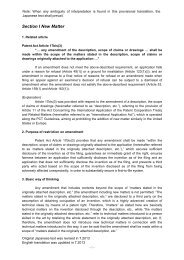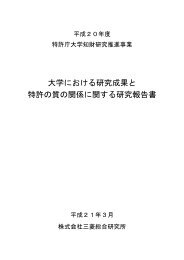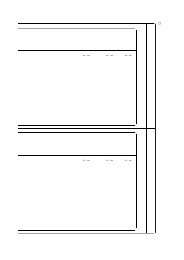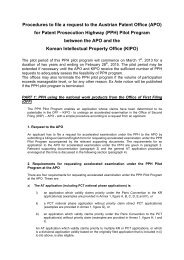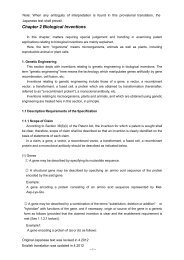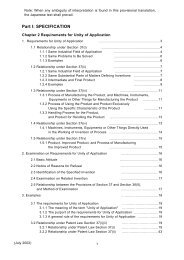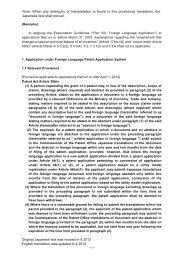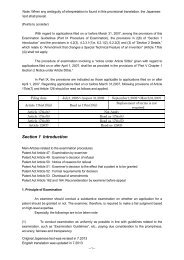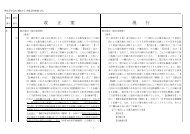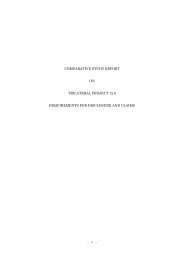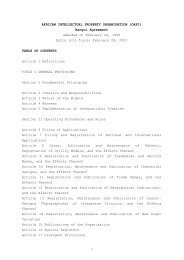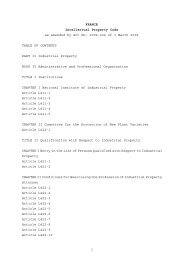Chapter 2 Novelty and Inventive Step - Japan Patent Office
Chapter 2 Novelty and Inventive Step - Japan Patent Office
Chapter 2 Novelty and Inventive Step - Japan Patent Office
Create successful ePaper yourself
Turn your PDF publications into a flip-book with our unique Google optimized e-Paper software.
Part II <strong>Chapter</strong> 2 <strong>Novelty</strong> <strong>and</strong> <strong>Inventive</strong> <strong>Step</strong><br />
inventions provide problems to be solved or advantageous effects of the inventions similar or<br />
identical to those in the matters used to specify the inventions describing the functions or<br />
characteristics, where the functions or characteristics of the cited inventions are highly likely to be<br />
included in those of the claimed inventions.<br />
In addition, the novelty of the claimed inventions shall be determined through regular<br />
approaches rather than this special approach when possible.<br />
(4) Claims defining the products by manufacturing processes<br />
I. It is sometimes extremely difficult to determine the structures of products per se provided<br />
in the claims defining the products by manufacturing processes. For these claims, as mentioned<br />
in the above (3), the examiners shall send a notice of the reasons for refusal for the lack of<br />
novelty when they have a reasonable doubt that products in the claimed inventions <strong>and</strong> cited<br />
inventions are identical, without comparing products of the claimed inventions to those of the<br />
cited inventions to find exact corresponding <strong>and</strong> differing points, unless differences are found in<br />
other sections.<br />
However, this approach should not be applied to the inventions, whose matters used to<br />
specify the cited invention define the products by the manufacturing processes, as cited<br />
inventions:<br />
II. The following are examples in which the examiners should have a reasonable doubt:<br />
- The cited inventions are found to provide products with similar starting materials to <strong>and</strong><br />
manufactured by the same manufacturing process as those of the claimed inventions;<br />
- The cited inventions are found to provide products that have the same starting material<br />
as <strong>and</strong> manufactured by the similar manufacturing process to those of the claimed inventions;<br />
- After the filing of the claimed inventions for products, structures of the products that are<br />
identical to those of the claimed inventions <strong>and</strong> the products have been publicly known before the<br />
filing; <strong>and</strong><br />
- The cited inventions are found to be identical or similar to the arts described in the<br />
working examples in the specifications or the drawings of the claimed inventions.<br />
In addition, the novelty of the inventions shall be determined through regular approaches<br />
rather than these special approaches when possible.<br />
1.6 Notice of Reasons for Refusal under the Provision of <strong>Patent</strong> Act Article 29(1)<br />
A notice of reasons for refusal is sent to applicants when the examiners have concluded<br />
that claimed inventions are unpatentable under Article 29(1).<br />
The applicants have opportunities to argue against the notice of reasons for refusal or<br />
clarify their refused applications by submitting written opinions or certificates of experimental<br />
results.<br />
The reason for refusal is cancelled when the applicants deny the convictions of the<br />
examiners that the claimed inventions are unpatentable according to Article 29(1) to the extent<br />
that truth or falsity becomes unclear, by submitting written opinions or certificates of experimental<br />
results. The claimed invention is refused due to lack of novelty when the convictions of the<br />
examiners do not change.<br />
15



